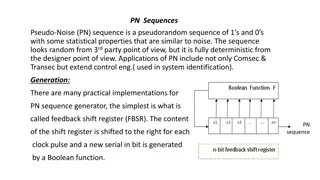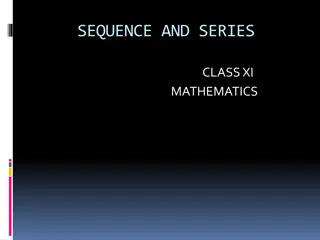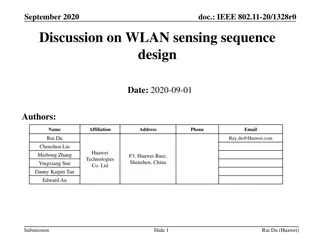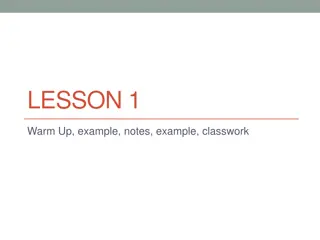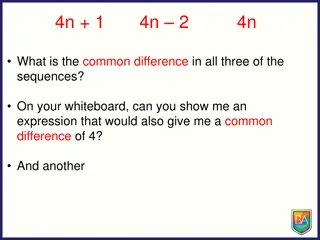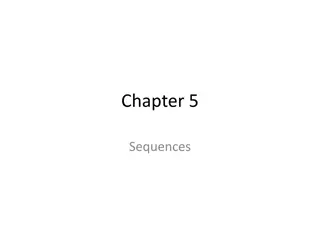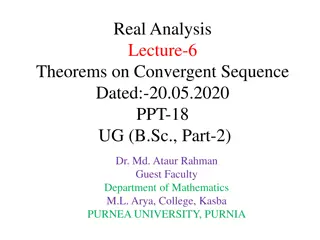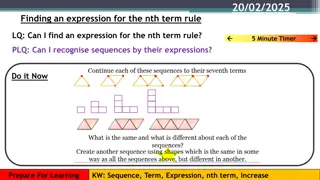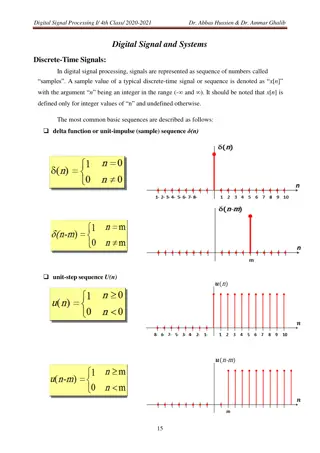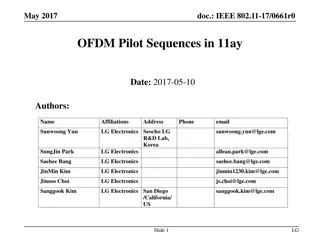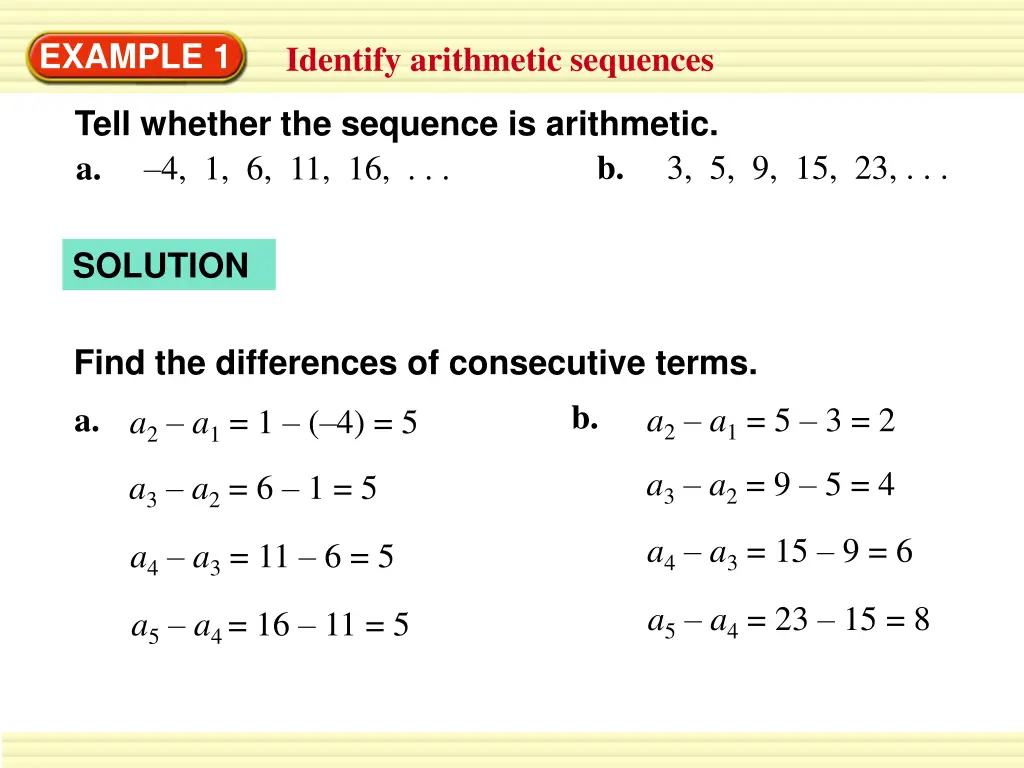
Arithmetic Sequences Examples and Solutions
Explore various examples of arithmetic sequences, learn how to identify them, write rules for nth terms, and interpret common differences with detailed solutions.
Uploaded on | 1 Views
Download Presentation

Please find below an Image/Link to download the presentation.
The content on the website is provided AS IS for your information and personal use only. It may not be sold, licensed, or shared on other websites without obtaining consent from the author. If you encounter any issues during the download, it is possible that the publisher has removed the file from their server.
You are allowed to download the files provided on this website for personal or commercial use, subject to the condition that they are used lawfully. All files are the property of their respective owners.
The content on the website is provided AS IS for your information and personal use only. It may not be sold, licensed, or shared on other websites without obtaining consent from the author.
E N D
Presentation Transcript
EXAMPLE 1 Identify arithmetic sequences Tell whether the sequence is arithmetic. a. 4, 1, 6, 11, 16, . . . b. 3, 5, 9, 15, 23, . . . SOLUTION Find the differences of consecutive terms. a. b. a2 a1 = 5 3 = 2 a2 a1 = 1 ( 4) = 5 a3 a2 = 9 5 = 4 a3 a2 = 6 1 = 5 a4 a3 = 15 9 = 6 a4 a3 = 11 6 = 5 a5 a4 = 23 15 = 8 a5 a4 = 16 11 = 5
EXAMPLE 1 Identify arithmetic sequences ANSWER ANSWER The differences are not constant, so the sequence is not arithmetic. Each difference is 5, so the sequence is arithmetic.
for Example 1 GUIDED PRACTICE 1.Tell whether the sequence17, 14, 11, 8, 5, . . . is arithmetic. Explain why or why not. Arithmetic; There is a common differences of 3 ANSWER
EXAMPLE 2 Write a rule for thenth term a. Write a rule for the nth term of the sequence. Then find a15. a. 4, 9, 14, 19, . . . b. 60, 52, 44, 36, . . . SOLUTION The sequence is arithmetic with first term a1 = 4 and common difference d = 9 4 = 5. So, a rule for thenth term is: an= a1+ (n 1) d = 4+ (n 1)5 = 1 + 5n Simplify. Write general rule. Substitute 4 for a1 and 5 for d. The 15th term is a15 = 1 + 5(15) = 74.
EXAMPLE 2 Write a rule for thenth term The sequence is arithmetic with first term a1 = 60 and common difference d = 52 60 = 8. So, a rule for the nth term is: b. an= a1+ (n 1) d = 60+ (n 1)( 8) Write general rule. Substitute 60 for a1 and 8 for d. = 68 8n Simplify. The 15th term is a15 = 68 8(15) = 52.
EXAMPLE 3 Write a rule given a term and common difference One term of an arithmetic sequence is a19 = 48. The common difference is d = 3. a. Write a rule for the nth term. b. Graph the sequence. SOLUTION a. Use the general rule to find the first term. an= a1+ (n 1)d Write general rule. a19 =a1+ (19 1)d Substitute 19 forn 48 = a1 + 18(3) Substitute 48 for a19 and 3 for d. 6 = a1 Solve for a1. So, a rule for the nth term is:
EXAMPLE 3 Write a rule given a term and common difference an= a1+ (n 1)d = 6+ (n 1)3 = 9 + 3n Write general rule. Substitute 6 for a1 and 3 for d. Simplify. b. Create a table of values for the sequence. The graph of the first 6 terms of the sequence is shown. Notice that the points lie on a line. This is true for any arithmetic sequence.
EXAMPLE 4 Write a rule given two terms Two terms of an arithmetic sequence are a8 = 21 and a27 = 97. Find a rule for the nth term. SOLUTION STEP 1 Write a system of equations using an= a1 +(n 1)dand substituting 27 for n(Equation 1) and then 8 for n (Equation 2).
EXAMPLE 4 Write a rule given two terms a27 = a1 + (27 1)d a8= a1 + (8 1)d 97 = a1 + 26d 21 = a1 + 7d Equation 1 Equation 2 STEP 2 Solve the system. 76 = 19d Subtract. 4 = d Solve for d. 97 = a1 + 26(4) Substitute for d in Equation 1. 7 = a1 an= a1 + (n 1)d Solve for a1. STEP 3 Find a rule for an. Write general rule. Substitute for a1 and d. = 7 + (n 1)4 = 11 + 4n Simplify.
for Examples 2, 3, and 4 GUIDED PRACTICE Write a rule for the nth term of the arithmetic sequence. Then find a20. 2. 17, 14, 11, 8, . . . an= 20 3n; 40 ANSWER 3. a11 = 57, d = 7 an= 20 7n; 120 ANSWER 4. a7 = 26, a16= 71 an= 9 + 5n; 91 ANSWER
EXAMPLE 5 Standardized Test Practice SOLUTION a1 = 3 + 5(1) = 8 a20= 3 + 5(20) =103 S20 = 20( ) = 1110 Identify first term. Identify last term. Write rule for S20, substituting 8 for a1 and 103 for a20. Simplify. 8 + 103 2 ANSWER The correct answer is C.
EXAMPLE 1 Identify geometric sequences Tell whether the sequence is geometric. a. 4, 10, 18, 28, 40, . . . b. 625, 125, 25, 5, 1, . . . SOLUTION To decide whether a sequence is geometric, find the ratios of consecutive terms. a. a1 a2=10 a3 a2 a4 a3=28 a5 a4=40 =18 9 5 5 2 18=14 28=10 = 4= 10 9 7 ANSWER The ratios are different, so the sequence is not geometric.
EXAMPLE 1 Identify geometric sequences a1 a2=125 a3 a2 a4 a3=5 a5 a4=1 =25 125= 1 5 625=1 25=1 b. 5 5 5 ANSWER Each ratio is , so the sequence is geometric. 1 5
for Example 1 GUIDED PRACTICE Tell whether the sequence is geometric. Explain why or why not. 1. 81, 27, 9, 3, 1, . . . 1 3 ANSWER Each ratio is , So the sequence is geometric. 2. 1, 2, 6, 24, 120, . . . The ratios are different. The sequence is not geometric. ANSWER 3. 4, 8, 16, 32, 64, . . . 2 Each ratio is. So the sequence is geometric. ANSWER
EXAMPLE 2 Write a rule for the nth term Write a rule for the nth term of the sequence. Then find a7. a. 4, 20, 100, 500, . . . b. 152, 76, 38, 19, . . . SOLUTION The sequence is geometric with first term a1 = 4 and common ratio r =20 4 a. = 5. So, a rule for the nth term is: Write general rule. an= a1 r n 1 = 4(5)n 1 Substitute 4 for a1 and 5 for r. The 7th term is a7 = 4(5)7 1 = 62,500.
EXAMPLE 2 Write a rule for the nth term b. The sequence is geometric with first term a1 = 152 and common ratio r = 76 2.So, a rule for the nth term is: 152= 1 Write general rule. an= a1 r n 1 n 1 = 152( ) 1 2 1 2 Substitute 152 for a1 and for r. ( ) 7 1 19 8 1 2 The 7th term is a7 = 152 =
EXAMPLE 3 Write a rule given a term and common ratio One term of a geometric sequence is a4 =12. The common ratio is r = 2. a. Write a rule for the nth term. b. Graph the sequence. SOLUTION a. Use the general rule to find the first term. an= a1r n 1 a4= a1r 4 1 12 = a1(2)3 1.5 = a1 Solve for a1. Write general rule. Substitute 4 for n. Substitute 12 for a4 and 2 for r.
EXAMPLE 3 Write a rule given a term and common ratio So, a rule for the nth term is: Write general rule. an= a1r n 1 = 1.5(2) n 1 Create a table of values for the sequence. The graph of the first 6 terms of the sequence is shown. Notice that the points lie on an exponential curve. This is true for any geometric sequence with r > 0. Substitute 1.5 for a1 and 2 for r. b.
EXAMPLE 4 Write a rule given two terms Two terms of a geometric sequence are a3 = 48 and a6 = 3072. Find a rule for the nth term. SOLUTION STEP 1 Write a system of equations using an= a1r n 1 and substituting 3 for n(Equation 1) and then 6 for n(Equation 2). a3= a1r 3 1 48 = a1 r 2 Equation 1 a6= a1r 6 1 3072 = a1r 5 Equation 2
EXAMPLE 4 Write a rule given two terms STEP 2 Solve the system. 48 r2 3072 = 48 Solve Equation 1 for a1. =a1 (r5 ) Substitute for a1in Equation 2. r2 3072 = 48r3 4 = r 48 = a1( 4)2 3 = a1 Simplify. Solve for r. Substitute for rin Equation 1. Solve for a1. STEP 3 an= a1r n 1 Write general rule. an= 3( 4)n 1 Substitute for a1 and r.
for Examples 2, 3 and 4 GUIDED PRACTICE Write a rule for the nth term of the geometric sequence. Then find a8. 4. 3, 15, 75, 375, . . . 234,375 ; an = 3( 5 )n 1 ANSWER 5. a6 = 96, r = 2 ANSWER 384; an = 3(2)n 1 6. a2 = 12, a4 = 3 1 2 0.1875 ; an = 24( )n 1 ANSWER



